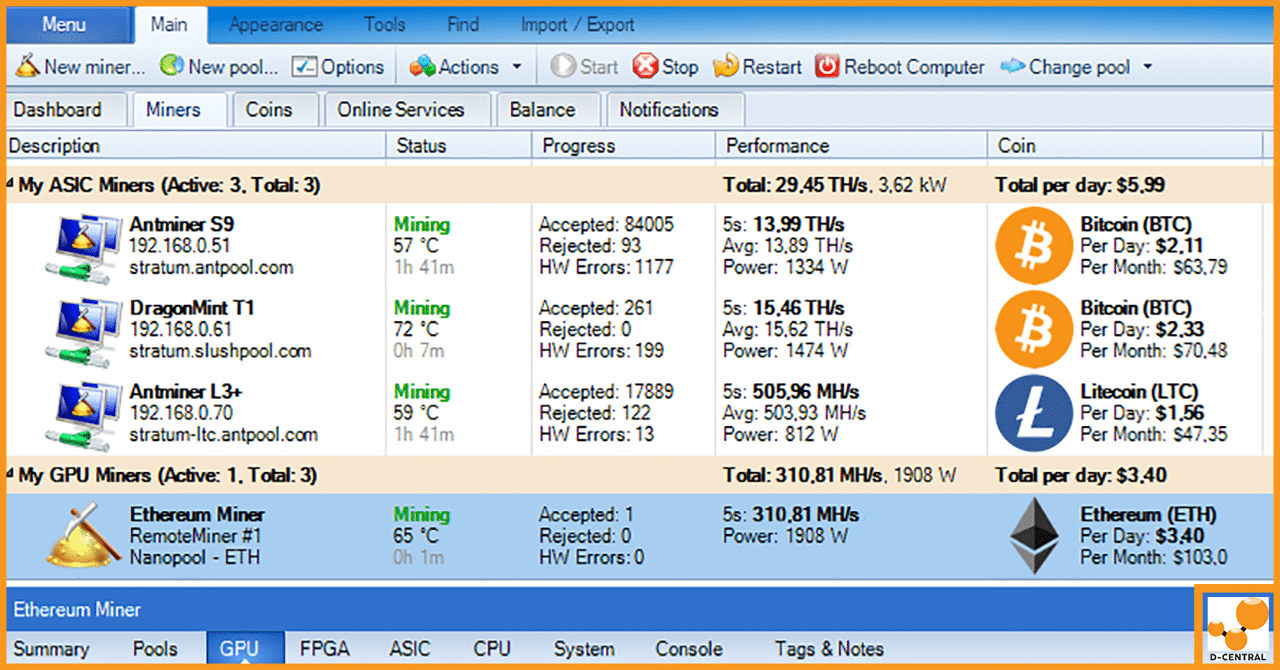
Mastering the Art of ASIC Repair
Are you interested in repairing ASIC machines such as L3s, S9s, S17s and S19s? If so, receiving proper training from
4479 Desserte Nord Autoroute 440, Laval, QC H7P 6E2

In an era where technology and sustainability are becoming increasingly intertwined, the intersection between Bitcoin mining and farming presents a revolutionary frontier. This confluence not only offers economic advantages but also paves the way for a more sustainable and efficient agricultural sector. From dual-purpose mining that heats livestock shelters to the utilization of renewable energy sources, the possibilities are both fascinating and endless.
At the forefront of this innovative amalgamation is D-Central Technologies, Canada’s premier ASIC repair center and a trusted name in the Bitcoin mining industry. With a strong reputation across multiple sales channels and a commitment to Bitcoin maximalism and the cypherpunk ethos, D-Central Technologies is uniquely positioned to explore and champion this intersection. Our core beliefs in the paramountcy of Bitcoin and the power of strong cryptographic techniques align perfectly with the ethos of this article, which aims to delve into the multifaceted ways Bitcoin mining can contribute to farming practices.
By marrying the technological prowess of Bitcoin mining with the age-old industry of farming, we are not just talking about a win-win situation; we are talking about setting new standards for environmental sustainability and economic viability in both sectors.
Stay tuned as we unpack the various dimensions of this exciting integration, backed by the expertise and reputation of D-Central Technologies.
The idea of dual-purpose mining is a groundbreaking one that transcends the traditional boundaries of Bitcoin mining. Instead of solely focusing on hashing algorithms to earn Bitcoin, dual-purpose mining leverages the heat generated from the mining process for other practical applications. This concept is particularly relevant in farming, where the heat can be used for a variety of purposes, such as warming livestock shelters or greenhouses.
One of the most compelling examples of dual-purpose mining in action is the partnership between a Dutch farmer and a Bitcoin miner. In this symbiotic relationship, the Bitcoin miner places his mining rigs in the farmer’s greenhouses. The heat generated from the mining process is then used to maintain optimal temperatures for growing produce.
This innovative approach has several environmental advantages. Firstly, it reduces the farmer’s dependency on natural gas or other fossil fuels for heating, thereby lowering the carbon footprint of the farming operation. Secondly, the Bitcoin miner, by paying the electricity bill, ensures that the operation remains energy-efficient and potentially opens the door for the use of renewable energy sources. This aligns well with D-Central Technologies’ commitment to environmental sustainability and our belief in Bitcoin as a green technology.
From an economic standpoint, the benefits are equally compelling. The farmer gains free heat for his crops, reducing operational costs. The Bitcoin miner, in turn, finds a cost-effective solution for heat dissipation, a common challenge in mining operations. This mutually beneficial arrangement creates a new revenue stream for both parties and exemplifies the economic viability of integrating Bitcoin mining into traditional farming practices.
By embracing dual-purpose mining, we are not just optimizing resource utilization but also creating a sustainable and economically viable model that could revolutionize both the Bitcoin mining and farming sectors. This case study serves as a testament to the untapped potential of such partnerships, backed by the expertise and reputation of D-Central Technologies in the Bitcoin mining industry.
In the context of farming, the utilization of renewable energy takes on an added layer of significance. Many farms already employ renewable energy sources for their operations, generating excess energy that often goes unused. This excess energy can be seamlessly channelled into Bitcoin mining rigs, turning what would be ‘wasted’ energy into a valuable asset. For instance, a farm with a solar panel installation can use the excess solar power generated during the day to power Bitcoin mining rigs, thereby optimizing energy use and adding an additional revenue stream.
The use of renewable energy in Bitcoin mining has the potential to make the operation carbon-negative, meaning it removes more carbon from the atmosphere than is emitted. This is a game-changing prospect contrary to popular belief that Bitcoin mining is bad for the environment. As a company deeply rooted in the principles of Bitcoin, we recognize the transformative power of strong cryptographic techniques and privacy-centric technologies. By advocating for carbon-negative Bitcoin mining operations, we are not only staying true to our commitment to environmental sustainability but also pioneering a path for societal and political change.
The integration of renewable energy in Bitcoin mining on farms offers both environmental and economic benefits, setting a new standard for sustainability in both industries. This approach is in perfect harmony with the values and commitments upheld by D-Central Technologies, further solidifying our role as leaders in the Bitcoin mining industry.
Methane is a potent greenhouse gas that has significant implications for climate change. According to the International Energy Agency (IEA), the concentration of methane in the atmosphere is around two-and-a-half times greater than pre-industrial levels and is steadily increasing. The largest source of anthropogenic methane emissions is agriculture, responsible for around one-quarter of emissions. Stanford-led research also indicates that methane is more than 80 times more potent than carbon dioxide in terms of warming the climate system over the first two decades after its release.
Bitcoin mining offers an innovative solution to this pressing environmental issue. By using methane as a fuel source for Bitcoin mining rigs, the methane is converted into less harmful emissions like CO2 and water. This process is known as methane mitigation and aligns perfectly with D-Central Technologies’ commitment to environmental sustainability and our belief in Bitcoin as a green technology.
From an economic standpoint, methane mitigation through Bitcoin mining provides farmers with a new revenue stream. Instead of venting or flaring methane, it can be used to generate electricity for mining, thereby creating an additional income source. Environmentally, this approach significantly reduces the farm’s methane emissions, contributing to a decrease in its overall carbon footprint. The IEA suggests that tackling methane emissions is central to minimizing adverse social and environmental impacts.
By integrating methane mitigation strategies with Bitcoin mining, we are setting a new standard for responsible and sustainable practices in both the farming and Bitcoin mining sectors.
Grid stabilization refers to the process of balancing the supply and demand of electricity in a power grid to ensure its reliable and efficient operation. This is crucial for preventing blackouts and ensuring that electricity is distributed evenly across the grid.
Bitcoin mining operations have the unique ability to rapidly scale up or down their electricity consumption. This flexibility can be leveraged to balance the electrical grid, especially during times of peak demand or supply fluctuations. According to Jaime Leverton, CEO of Hut8 Mining, Bitcoin mining can help to stabilize grids by balancing the supply and demand of electricity. In Texas, for example, software is being used to balance the supply and demand of electricity to its grid using Bitcoin miners.
In Quebec, Bitcoin miners are known to engage in load shedding during winter peaks, allowing the recovery of about 300MWh for Quebecers. This level of flexibility is unparalleled in other industries, making Bitcoin mining a valuable asset for grid stabilization.
Another case is in Medicine Hat, Alberta, where Bitcoin mining operations can power down during peak demand activities like snowstorms and feed the entire amount of electricity back into the grid.
In the United States, Bitcoin mining operations are increasingly participating in demand response programs, providing grid services and encouraging renewable energy. The industry is also working with utilities and grid operators to provide needed demand flexibility.
By incorporating Bitcoin mining into grid stabilization strategies, we can not only make the grid more resilient but also promote the use of renewable energy sources.
Bitcoin mining operations produce a significant amount of heat, which is often considered a byproduct. However, this heat can be captured and repurposed for various applications, including food dehydration and lamb incubation. This not only offsets costs but also reduces energy waste, creating new revenue streams for miners.
Food dehydration is a process that removes moisture from food to preserve it. Excess heat from Bitcoin mining can be effectively used for this purpose. For example, the first known case of using mining heat for food dehydration was in 2011, when a bag of mining-heated dried strawberries was sold for 1.5 BTC at a local grocery store. This innovative approach allows for the preservation of fruits and vegetables, thereby reducing food waste and contributing to sustainability.
In a tweet by Rev.Hodl, the concept of using Bitcoin mining heat for lamb incubation is highlighted as a practical application on a farm. The tweet emphasizes the multifaceted utility of a Bitcoin miner in a farming setting, including its use as a “portable space heater, lamb incubator, food dehydrator, [and for] excess solar power hashing.” This real-world example underscores the innovative ways in which the heat generated from Bitcoin mining can be repurposed for agricultural uses, including the critical task of keeping newborn lambs warm.
Every farmer a miner. Few understand this. Portable space heater, lamb incubator, food dehydrator, excess solar power hashing. The utility of a Bitcoin miner on a farm is innumerable. #plebminer pic.twitter.com/lln5qn63XT
— Rev.Hodl (@HodlRev) May 18, 2023
By incorporating these innovative uses of Bitcoin mining heat into farming practices, we are not only optimizing resource utilization but also contributing to environmental sustainability.
Farmers have a unique opportunity to contribute to the Bitcoin network, especially given their often-underutilized resources. Whether it’s excess renewable energy, unused barn space, or even waste products like methane, these resources can be repurposed for Bitcoin mining. By doing so, farmers not only gain an additional revenue stream but also become active participants in a global financial network.
The intersection of Bitcoin mining and farming is a groundbreaking frontier that offers a plethora of opportunities for both sectors. From dual-purpose mining that provides heat for livestock shelters and greenhouses to the utilization of renewable energy and methane mitigation, the possibilities are both fascinating and endless. The heat generated from mining operations can also be repurposed for various agricultural needs, such as food dehydration and lamb incubation, as highlighted by real-world examples.
By marrying the technological prowess of Bitcoin mining with the age-old industry of farming, we are not just talking about a win-win situation; we are talking about setting new standards for environmental sustainability and economic viability. The flexibility of Bitcoin mining operations in grid stabilization further underscores its utility in creating a more resilient and sustainable power grid.
At D-Central Technologies, we are committed to leveraging the transformative power of Bitcoin and strong cryptographic techniques for societal and economic betterment. The integration of Bitcoin mining into farming practices aligns perfectly with our core beliefs and commitments, setting a new standard for responsible and sustainable practices in both sectors.
In conclusion, the multifaceted utility of Bitcoin mining in farming is not just a novel concept but a revolutionary approach that has the potential to redefine the paradigms of sustainability and economic viability in both industries. As we continue to explore and champion this exciting integration, we are setting the stage for a more sustainable, efficient, and economically viable future.
What is dual-purpose mining?
Dual-purpose mining represents a groundbreaking approach that encompasses more than just Bitcoin mining for profit. It utilizes the heat generated during the mining process for other applications, like warming livestock shelters or greenhouses. The approach presents environmental and economic advantages.
What’s the relationship between renewable energy and Bitcoin mining?
Many farms utilize renewable energy sources for their operations, often generating excess energy. This excess can be channeled into Bitcoin mining rigs, turning the potentially wasted energy into valuable digital assets. The practice can lead to carbon-negative Bitcoin mining operations.
What is methane mitigation through Bitcoin mining?
Methane mitigation refers to the use of methane as a fuel source for Bitcoin mining rigs. This process converts the potent greenhouse gas methane into less harmful emissions like CO2 and water, thus offering an innovative approach to a pressing environmental issue.
How can Bitcoin mining help with grid stabilization?
Bitcoin mining operations have the unique ability to rapidly scale up or down their electricity consumption. This flexibility can help balance the power grid, particularly during times of peak demand or supply fluctuations.
What are some innovative uses for heat generated from Bitcoin mining operations?
Bitcoin mining operations produce a significant amount of heat, which can be repurposed for various applications such as food dehydration and lamb incubation. This not only helps reduce energy waste but also introduces new revenue streams for miners.
DISCLAIMER: D-Central Technologies and its associated content, including this blog, do not serve as financial advisors or official investment advisors. The insights and opinions shared here or by any guests featured in our content are provided purely for informational and educational purposes. Such communications should not be interpreted as financial, investment, legal, tax, or any form of specific advice. We are committed to advancing the knowledge and understanding of Bitcoin and its potential impact on society. However, we urge our community to proceed with caution and informed judgment in all related endeavors.
Related Posts

Are you interested in repairing ASIC machines such as L3s, S9s, S17s and S19s? If so, receiving proper training from

Bitcoin mining has long been synonymous with hefty power requirements and industrial-grade setups, often making it a challenge for home

In the dynamic world of Bitcoin mining, efficiency and adaptability are key to staying ahead of the curve. As mining